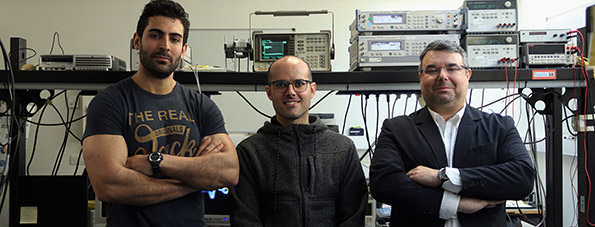A temporal supersymmetry
Researchers at the UPV pave the way to designing omnidirectional invisible materials
[ 07/05/2020 ]
Researchers at the Universitat Politècnica de València (UPV), belonging to the Nanophotonics Technology Center, have taken a new step in designing omnidirectional invisible materials. At their laboratories, they have discovered a new fundamental symmetry in the laws of electromagnetism, acoustics and elasticity: a temporal supersymmetry. This finding has been published in the Nature Communications journal.
According to Carlos García Meca and Andrés Macho Ortiz, researchers at NTC-UPV, this new symmetry allows the conservation of the linear moment between dramatically different physical systems. This paves the way to designing pioneering optical, acoustic and elastic devices, including invisible omnidirectional, polarization-independent materials, ultra-compact frequency shifters, isolators and pulse-shape transformers.
“These devices allow us to unusually modify different properties of light signals inside photonic circuits to process the spread of information. This is vital in communication systems. Moreover, we can adapt the functionality of those devices to the requirements at any time, as they are dynamically configurable,” explained Carlos García Meca.
For designing these new devices, the key lies in changing the refraction index, which in this case is not generated in space but in time. “The Supersymmetry technique tells us how to vary the refraction index of an object to have the light completely transmitted, avoiding undesired reflections,” said Andrés Macho Ortiz.
The property of non-reflection is particularly useful for designing new photonic circuits. “Its implementation allows us to increase the speed of communications inside and makes them more compact and configurable without the signal that transports information bits being reflected back,” explained Carlos and Andrés.
In general, the reflection of materials whose properties vary in time does not depend on the direction of light propagation. Therefore, “the absence of reflection in the proposed materials is linked to a total transparency, which results in the concept of omnidirectional invisibility: whatever the direction of light hitting those materials is, their presence is undetectable,” concluded the authors.
Symmetries
The discovery of symmetries in the nature is a cornerstone in physics that allows us to find the conservation laws governing the universe. For example, electric charge, energy and mass conservation (coming from symmetries in physical laws governing electromagnetism, thermodynamics and chemistry) has allowed humans to have the ability to develop this technology (circuits, nuclear power stations, drugs...).
Exceptionally, supersymmetry was originally conceived in quantum physics as a hypothetical symmetry between particles that could explain all interactions in nature: nuclear forces, gravity and electromagnetism.
Outstanding news
 Study a degree at the best technological university in Spain
Study a degree at the best technological university in Spain
The Universitat Politècnica de València is ranked number 1 among Spanish technology universities, according to the Shanghai ranking
 Highly Cited Researchers 2025
Highly Cited Researchers 2025
Avelí Corma, Juan Bisquert and Luis Guanter, the international scientific elite with a Universitat Politècnica de València hallmark
 Historic Milestone in Spanish Higher Education
Historic Milestone in Spanish Higher Education
The UPV inaugurates the Beihang Valencia Polytechnic Institute, the first Spanish university center in China
 Study in English
Study in English
The UPV offers eight degrees, 16 master's and 650 courses in English for the 2025-26 academic year
 A Latin Grammy... with the UPV hallmark
A Latin Grammy... with the UPV hallmark
'Music teaches us to listen and live together,' says Rafael Serrallet, Doctor of Music at the UPV, awarded in Las Vegas as the author of the Best Instrumental Album of 2025
 THE Impact Ranking
THE Impact Ranking
The UPV, the Spanish university with the greatest social and economic impact in the world

